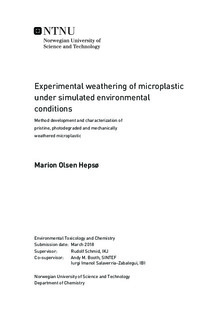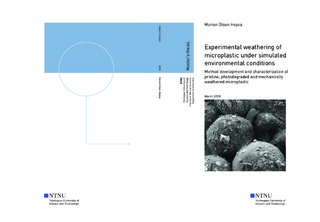| dc.description.abstract | The aim of this master thesis was to investigate the physico-chemical changes of microplastic (MP) weathered under simulated environmental conditions: floating on the ocean surface and in the intertidal zone. Polyethylene (PE) and polystyrene (PS) of two different sizes (10 and 100 µm) were weathered in rotating seawater for 80 days under two different conditions: (1) photodegradation equivalent to ≤616 average days in Trondheim and (2) mechanical degradation with sediment. Sample extraction involved NaCl density separation, filtration and drying. Surface morphology and size was examined by light- and scanning electron microscopy (SEM), while chemical analysis was conducted using Fourier Transform infrared spectroscopy (FTIR) and pyrolysis-gas chromatography-mass spectrometry (Pyr-GC/MS).
Analyses revealed <1 % w/w residual sediment in the MP samples, likely due to heteroaggregation with fragmented sediment (clay), which also coated the MP particles and accumulated in gaps. A temporal trend in surface roughness was observed for the photodegraded MP. Oxidation was apparent in PS after 80 days of photodegradation, and a range of oxidation products and polymer fragments were desorbed by Pyr-GC/MS at 250 °C. Pyrolysis (600 °C) chromatograms of both PE and PS changed with weathering time, indicating chain scission and/or leaching of polymer oligomers. Fragmentation did not occur for the 10 µm MP particles, while the size of the 100 µm mechanically degraded MPs changed with weathering time. The size of potential MP fragments could not be assessed due to an overlapping size range with the residual sediment. Loss of small nanoplastic (NP) fragments from the MP surface is likely, but the analysis methods were not applicable to the nm-range.
The experimental challenges demonstrate the need for qualitative analysis; NaCl density separation is ineffective on inorganic particles <39 µm and visual identification of MP particles is insufficient. The use of spherical, pristine MP particles in abiotic media limits the environmental relevancy of the experiments. It can be concluded that degradation is largely initiated and accelerated by photooxidation, and PS is more susceptible to photodegradation than PE. While no reports of MP heteroaggregation with clay were found in published literature, it is a plausible sedimentation mechanism. Oxidation and heteroaggregation has implications for e.g. the interaction between MP and microorganisms, chemical adsorption/desorption, fragmentation, transport and ultimate fate in the environment. | |

